Genealogy
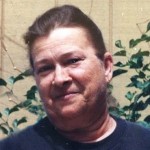 Years ago when my girls were young, the school systems…at least in the Casper area, had a program whereby the kids were checked for symptoms of Streptococcus bacteria, or as we knew it…Strep Throat. Since I was not working outside the home, I volunteered to help with that program. That was where I first met the mother, Pat Neville, of my dear friend, Becky Neville Osborne. Pat taught me the ropes, and we worked together in that program for eight years. Pat has gone on to be with the Lord now, but the friendship that blossomed with her daughter, from her own childhood, has continued through the years, and continues to bless my life every day.
Years ago when my girls were young, the school systems…at least in the Casper area, had a program whereby the kids were checked for symptoms of Streptococcus bacteria, or as we knew it…Strep Throat. Since I was not working outside the home, I volunteered to help with that program. That was where I first met the mother, Pat Neville, of my dear friend, Becky Neville Osborne. Pat taught me the ropes, and we worked together in that program for eight years. Pat has gone on to be with the Lord now, but the friendship that blossomed with her daughter, from her own childhood, has continued through the years, and continues to bless my life every day.
When Pat was teaching me the ropes of the throat culture program, I really didn’t know much about the Streptococcus bacteria, nor about how it had affected my grandmother, Anna Schumacher Spencer many years earlier. Streptococcus bacteria, is the same bacteria that causes Rheumatic fever, and years ago, that was a very dangerous disease. When Strep Throat is not treated with Penicillin to kill the bacteria, the bacteria just continues to run rampant in the system. Rheumatic fever is caused by a combination of bacterial infection and immune system overreaction, and it almost always follows a strep throat infection, which is an infection of the respiratory tract caused by bacteria of the Streptococcus family. The reason for throat cultures in the schools is that children are far more likely to get strep throat than adults…these days  anyway. Years ago, it was anybody’s guess.
anyway. Years ago, it was anybody’s guess.
While my grandmother was living in Casper, Wyoming where my aunts, Laura and Ruth were living at the time, she contracted Strep Throat, and probably didn’t even know it. Then it turned to Rheumatic Fever. Unchecked, Rheumatic Fever can cause heart problems, which was common in children years ago, but is much less common now due to the routine use of antibiotics. In fact, I don’t believe routine throat cultures are performed in the schools anymore. Strep Throat still exists, but now people have to go to their doctor to be swabbed.
Rheumatic Fever is most common in children under 15 years of age, but it can affect adults too…as was the case with my grandmother. As was the case with my grandmother, Streptococcus bacteria can attack the joints. It can also attack the central nervous system, brain and spinal cord, as well as the heart. In the heart the disease affects the inner lining of the heart, including the heart valves, which is known as endocarditis, the muscle of the heart, which is known as myocarditis, or the covering of the heart, which is known as pericarditis.
Sometimes, the body reacts with a huge immune system reaction to the affected areas. The immune system becomes so active that it attacks the affected tissues too. In the joints, this results in a temporary arthritis. In the heart, permanent damage to the heart valves can occur, also increasing the risk of heart problems in later 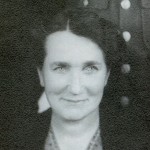 life. Rheumatic fever can also cause problems in the nervous system, but these are usually reversible.
life. Rheumatic fever can also cause problems in the nervous system, but these are usually reversible.
I do know that my grandmother spent her final years confined to a wheelchair, but I always thought it was because she had Rheumatoid Arthritis. Now I wonder if it was because of Rheumatic Fever. I also know that My great grandmother and uncle here sick with something that ended up causing temporary arthritis, so possibly they had it too. I guess I may never know for sure, but I do know that sometimes I wonder if the practice of taking throat cultures should have been stopped. It seems to me that it did a lot of people a lot of good, and probably saved a lives too.
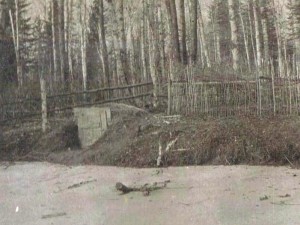 Years ago, long before refrigeration was safe to use, most people had a more primitive way to keep foods fresh or frozen. I say that this was before refrigeration was safe to use, because mechanical refrigeration was actually invented in 1748 by William Cullen and was demonstrated at the University of Glasgow. This version was not used for any practical purpose, however. In 1805, an American inventor named Oliver Evans designed the first refrigeration machine, and the first person to make a practical refrigerating machine was Jacob Perkins in 1834, using Ether in a vapor compression cycle. American physician, John Gorrie, built a refrigerator based on Oliver Evans’ design in 1844 which he used to make ice to cool the air for his yellow fever patients. German engineer Carl von Linden, patented not a refrigerator but the process of liquefying gas in 1876 that is part of basic refrigeration technology. Refrigerators in the late 1800s and up until 1929 used toxic gasses, such as ammonia, methyl chloride, and sulfur dioxide as refrigerants, which were responsible for several fatal accidents in the 1920s. I suppose the cost and the dangers of these early models were the main reasons that people continued to used the old fashioned version.
Years ago, long before refrigeration was safe to use, most people had a more primitive way to keep foods fresh or frozen. I say that this was before refrigeration was safe to use, because mechanical refrigeration was actually invented in 1748 by William Cullen and was demonstrated at the University of Glasgow. This version was not used for any practical purpose, however. In 1805, an American inventor named Oliver Evans designed the first refrigeration machine, and the first person to make a practical refrigerating machine was Jacob Perkins in 1834, using Ether in a vapor compression cycle. American physician, John Gorrie, built a refrigerator based on Oliver Evans’ design in 1844 which he used to make ice to cool the air for his yellow fever patients. German engineer Carl von Linden, patented not a refrigerator but the process of liquefying gas in 1876 that is part of basic refrigeration technology. Refrigerators in the late 1800s and up until 1929 used toxic gasses, such as ammonia, methyl chloride, and sulfur dioxide as refrigerants, which were responsible for several fatal accidents in the 1920s. I suppose the cost and the dangers of these early models were the main reasons that people continued to used the old fashioned version.
The old fashioned way to keep foods fresh or frozen, involved using ice and snow, which they would bring in from the mountains, or use what was on the ground, if it was available. They would dig a cellar in the ground, 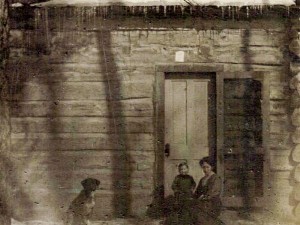 and line it with wood or straw. Then they packed it with snow and ice, and the food was placed in the cellar. It was this type of refrigeration system that my grandparents, Allen and Anna Spencer, were using at the time my Aunt Laura Fredrick was a very little girl in about 1913. My grandparents were living in a wooded area in northern Minnesota near American Falls. Grandpa was working in the lumber business at that time.
and line it with wood or straw. Then they packed it with snow and ice, and the food was placed in the cellar. It was this type of refrigeration system that my grandparents, Allen and Anna Spencer, were using at the time my Aunt Laura Fredrick was a very little girl in about 1913. My grandparents were living in a wooded area in northern Minnesota near American Falls. Grandpa was working in the lumber business at that time.
According to my Uncle Bill Spencer, who was their second child, the cellar was probably not needed much in the long winter months, because the house stayed pretty cold up there anyway. I’m sure that they had wood for a fire, but then again, I suppose that everything they burned, was something that could not bring in money. Also, they lived in a log cabin, that was apparently not very well built, or at least the spaces in between the logs were not really well packed with mud to keep the cold winter air on the outside of the house, where it belonged.
I’m not sure how far the cellar was from the house, because, I can’t see the house in the picture, so it might have been a little way from the house, or the picture might have been taken from the house. Either way, getting food from the cellar was a bit of a process, because you don’t want to upset the cooling process by removing the straw too often, as it was part of what kept the ice and snow from melting.
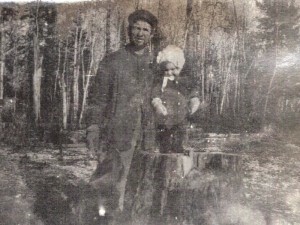 I can’t say when my grandparents got their first real refrigerator, but I expect that like many people of that time, they were a little bit leery of the early refrigerators, after hearing about people dying because the gasses leaked out of the unit. I suppose it was the price people paid to be able to use some of the early inventions, but many people felt that the price was too high, so they waited until these new fangled gadgets were proven safe before they took a chance on them. And, I’m sure that like any new thing, they were pretty expensive early on too. The cellar would work just fine for now, and therefore, that is what my grandparents were using at that time in our family history. These days, we would be shocked at such a method of keeping food fresh.
I can’t say when my grandparents got their first real refrigerator, but I expect that like many people of that time, they were a little bit leery of the early refrigerators, after hearing about people dying because the gasses leaked out of the unit. I suppose it was the price people paid to be able to use some of the early inventions, but many people felt that the price was too high, so they waited until these new fangled gadgets were proven safe before they took a chance on them. And, I’m sure that like any new thing, they were pretty expensive early on too. The cellar would work just fine for now, and therefore, that is what my grandparents were using at that time in our family history. These days, we would be shocked at such a method of keeping food fresh.
 Sometimes we think we know the whole story, and other times, we are pretty sure we don’t know the story at all. For me, the attack of Pearl Harbor is one that has seemed somewhat fuzzy. I mean I know that the Japanese attacked Pearl Harbor without warning on December the 7th of 1941…but why exactly. I have to wonder if I am the only one who isn’t exactly sure why my dad had to go to war in March of 1943 at the age of 18 years, along with several uncles. I know that his family knew that it was coming, and they were dreading it very much, but it was inevitable. We had been attacked. We must retaliate when we are attacked!! I understood that…but why were we attacked, and was it without provocation?
Sometimes we think we know the whole story, and other times, we are pretty sure we don’t know the story at all. For me, the attack of Pearl Harbor is one that has seemed somewhat fuzzy. I mean I know that the Japanese attacked Pearl Harbor without warning on December the 7th of 1941…but why exactly. I have to wonder if I am the only one who isn’t exactly sure why my dad had to go to war in March of 1943 at the age of 18 years, along with several uncles. I know that his family knew that it was coming, and they were dreading it very much, but it was inevitable. We had been attacked. We must retaliate when we are attacked!! I understood that…but why were we attacked, and was it without provocation?
Then I came across something that happened on Dec 1, 1941. This was the day that the Japanese made the decision to attack Pearl Harbor. This had been a possibility since the 1920s, but in 1931, with the Japanese invasion of Manchuria things got really tense. Japan was insistent on invading other countries, and were slowly moving into China. Beginning in 1938, the United States adopted increasingly tighter trade restrictions with Japan. Nevertheless, Japan would not be deterred from its expansionist policies, or from signing the Tripartite Pact in 1940 with Nazi Germany and Fascist Italy, officially forming the Axis Powers. In 1940, Japan invaded French Indochina so they could embargo all imports into China including war supplies from the United States. Some of these facts I knew, and some I didn’t. This is, of course, a very shortened version, but you can see that Japan was becoming increasingly more dangerous to the world, and to everyone in it.
On November 7, 1941, Secretary of State, Cordell Hull warned President Franklin Roosevelt’s cabinet that an  attack on the United States by Japan could happen at any time…without warning. On November 9th, Winston Churchill, who is my 15th cousin once removed, told the United States that if we went to war with Japan, the British Empire would declare war on Japan “within the hour.” It was a heavy responsibility for the United States, and for Secretary of State Hull. Nevertheless, something had to be done, and the world was looking to the United States to make the first move.
attack on the United States by Japan could happen at any time…without warning. On November 9th, Winston Churchill, who is my 15th cousin once removed, told the United States that if we went to war with Japan, the British Empire would declare war on Japan “within the hour.” It was a heavy responsibility for the United States, and for Secretary of State Hull. Nevertheless, something had to be done, and the world was looking to the United States to make the first move.
The decision to go to war is a difficult one, and one that I do not believe any civilized nation takes lightly. I’m sure that is why so many presidents have tried every possible restriction against some of the crazy dictators in this world. The problem is that so many of those dictators are not moved from their agendas…no matter what. Secretary of State Hull decided to try one more time, and so he wrote the Hull Note on November 26, 1941, which outlined ten proposals, some of which matched earlier Japanese proposals, but of others, Hull knew meant he was basically declaring war on Japan. The agreement would have to be made by November 29, and of course, history tells us that Japan did not agree. While Australia tried an offer to act as mediator between the United States and Japan on November 29th, they were told that the opportunity to settle this was past. On December 1, 1941, Japan’s Emperor Hirohito declared war against the United States, Britain, and the Netherlands, after rejecting the demands of the United States in the Hull Note, which the Japanese later dubbed The Hull Ultimatum, as a way of making the United States look like they were to blame for all this.
It was this action…on this day in history, and the events leading up to this action, and those that would follow, including the attack on Pearl Harbor on December 7, 1941 that drew the United States and our allies into World War II, and that would ultimately bring about my dad’s part in that war…as well as the part played by so many others, including a number of my uncles. War is a horrible event, and one that I truly don’t believe anyone 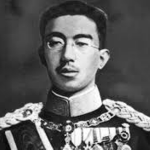 wants to be a part of, but sometimes it is inevitable. When a nation, such as Japan decides to take over the world…one weaker country at a time, someone has to step up and put a stop to it. Unfortunately, history has placed that responsibility in the hands of the United States many times. There are people who think we should just stay out of it, but if we did, just how long would it be before that nation came after us, because we appeared weak too. We might be able to fight them off…unless we have allowed our military might to be reduced to a point of making us as weak as some of these other nations. If we couldn’t fight them off, then our nation would lose it’s many freedoms, and we would find ourselves living under a dictator too. While I hate war too, I am not willing to lose the freedoms our military personnel have fought so hard for…are you?
wants to be a part of, but sometimes it is inevitable. When a nation, such as Japan decides to take over the world…one weaker country at a time, someone has to step up and put a stop to it. Unfortunately, history has placed that responsibility in the hands of the United States many times. There are people who think we should just stay out of it, but if we did, just how long would it be before that nation came after us, because we appeared weak too. We might be able to fight them off…unless we have allowed our military might to be reduced to a point of making us as weak as some of these other nations. If we couldn’t fight them off, then our nation would lose it’s many freedoms, and we would find ourselves living under a dictator too. While I hate war too, I am not willing to lose the freedoms our military personnel have fought so hard for…are you?
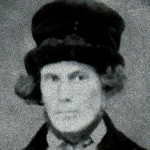
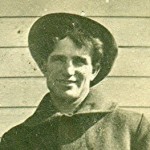 When a name is passed down from generation to generation dating back to the 1400s or even further back, it is often not easy to say just how that name got started, but once in a great while, we are able to find out for sure, because prior to a certain point, that name did not appear. Such is the case with my dad’s name in his family line. I have searched the family history pretty extensively, and while I could be mistaken, I don’t think that I am…for this part of the line anyway. My dad’s name is Allen Spencer, as was his dad’s and great grandfather’s. The name, Allen was first introduced with my dad’s great grandfather…as near as I can tell. It did not come from his parents, but rather from his grandparents. I’m sure that at this point, your are confused, so let me clarify this.
When a name is passed down from generation to generation dating back to the 1400s or even further back, it is often not easy to say just how that name got started, but once in a great while, we are able to find out for sure, because prior to a certain point, that name did not appear. Such is the case with my dad’s name in his family line. I have searched the family history pretty extensively, and while I could be mistaken, I don’t think that I am…for this part of the line anyway. My dad’s name is Allen Spencer, as was his dad’s and great grandfather’s. The name, Allen was first introduced with my dad’s great grandfather…as near as I can tell. It did not come from his parents, but rather from his grandparents. I’m sure that at this point, your are confused, so let me clarify this.
My fourth great grandfather, William Spencer, who was born on July 22, 1745, married a woman named Mercy Allen sometime before 1790. The exact date is unknown, but the only child anyone seems to know about, Christopher was born in 1790. Christopher Spencer was my third great grandfather, and the father of the first recorded Allen Spencer…who was, of course named after his grandmother…Mercy Allen. From that point on 
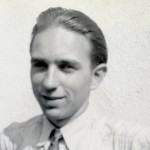 there would be an Allen from each generation, with only one exception that I am aware of…my sister, Allyn who would have been Allen, had she been a boy. Since she was not, my parents did the closest name they could…Allyn. Having all daughters, I’m sure you would expect that the Allen Spencer line would end with my parents, but it did not, because my sister, Caryl, upon the birth of her son, named him Allen Spencer Beach…thereby continuing the tradition. With the great care that was taken to continue the Allen Spencer name throughout the generations, I have to say that they succeeded…albeit with a little bit of creativity. While I don’t always think of my sister as being an Allen, she did go to school with a boy named Allyn, who was in fact called Allen. It is all in where you place the accent. We always pronounced hers like Lynn, with an A in front. It really had to be continued…it’s tradition. And it is my hope that my nephew, Allen will continue the tradition, or that someone else in the family will do so, because it seems a shame to let it end now.
there would be an Allen from each generation, with only one exception that I am aware of…my sister, Allyn who would have been Allen, had she been a boy. Since she was not, my parents did the closest name they could…Allyn. Having all daughters, I’m sure you would expect that the Allen Spencer line would end with my parents, but it did not, because my sister, Caryl, upon the birth of her son, named him Allen Spencer Beach…thereby continuing the tradition. With the great care that was taken to continue the Allen Spencer name throughout the generations, I have to say that they succeeded…albeit with a little bit of creativity. While I don’t always think of my sister as being an Allen, she did go to school with a boy named Allyn, who was in fact called Allen. It is all in where you place the accent. We always pronounced hers like Lynn, with an A in front. It really had to be continued…it’s tradition. And it is my hope that my nephew, Allen will continue the tradition, or that someone else in the family will do so, because it seems a shame to let it end now.
The rather funny thing about the name, Allen being a last name is that my dad always joked with us when we or 
 anyone else named their kids a name that could have been a last name. Names like Ryan, Garrett, and Kellie, while maybe not spelled exactly like the last name they came from, were nevertheless, originally last names. It’s funny that Dad teased about those names, saying they were last names, but didn’t make the same connection with his own name. I’m sure that was because he knew that it had been his dad’s and great grandfather’s name too. Still, like it or not, Dad’s name was originally the last name of his third great grandmother. Sorry to say it, Dad…but, that was once a last name!!
anyone else named their kids a name that could have been a last name. Names like Ryan, Garrett, and Kellie, while maybe not spelled exactly like the last name they came from, were nevertheless, originally last names. It’s funny that Dad teased about those names, saying they were last names, but didn’t make the same connection with his own name. I’m sure that was because he knew that it had been his dad’s and great grandfather’s name too. Still, like it or not, Dad’s name was originally the last name of his third great grandmother. Sorry to say it, Dad…but, that was once a last name!!

 Every time I make a new family connection…no matter which of the many branches of the family tree it happens to be on…I feel such excitement. These are new members of a family history that is ever evolving. We are related…be it by blood or by marriage, and now there are new people to get to know. They may or may not have new family history information, but quite often, they do. They may not even know that they have important information, until someone asks them a few questions. Still, most times they do know that they have important information, but they just don’t know that it is information that someone else is interested in.
Every time I make a new family connection…no matter which of the many branches of the family tree it happens to be on…I feel such excitement. These are new members of a family history that is ever evolving. We are related…be it by blood or by marriage, and now there are new people to get to know. They may or may not have new family history information, but quite often, they do. They may not even know that they have important information, until someone asks them a few questions. Still, most times they do know that they have important information, but they just don’t know that it is information that someone else is interested in.
In the past year and a half, I have had the wonderful opportunity to become friends with some family members on my father-in-law’s side of the family, that I knew about, but had never really connected with. My father-in-law, Walt Schulenberg, had a half brother, Andrew (Butch) Schulenberg, and I met him and his family years ago, when we went to a family reunion for the Schulenberg family. After my father-in-law’s passing, we needed to contact his half brother, and that conversation started my curiosity. I began searching Facebook, and came up with a familiar name…Andi Schulenberg.
When I first met Butch’s daughter, Andi Kay, she was a little girl, with a really cute name that just stuck in my head over the years. I didn’t have a chance to talk to her then, but I remember thinking that she was a cute little girl. She was a couple of years older than my oldest daughter, Corrie, and three years older than my youngest daughter, Amy. They could have been friends if they had lived in the same town. As I recall, Andi Kay was into sports, but I don’t recall what sport exactly. Andi has two brothers…an older brother, Tadd, and a younger brother Heath. At the time of the reunion, I don’t remember seeing her brothers, nor her mom, Charlys. I only remember meeting Butch and Andi Kay, and them only in passing.
Now that I have friended Andi on Facebook, I have to say, that as an adult, she is a very interesting person. We haven’t connected personally, just through Facebook, but I like her a lot. She is the mother of a nine year old boy named Calen, who is her pride and joy. Andi is a therapist at the Northern Wyoming Mental Health Center in Sheridan, Wyoming. She is bright and cheerful, with a smile that makes you feel like she is your friend right away. Through Andi, I have connected with Jennifer Schulenberg, who probably doesn’t know it, but she is the second Jennifer Schulenberg. The first one is my sister-in-law, Jennifer Schulenberg Parmely. The current Jennifer Schulenberg is married to Andi’s brother, Heath Schulenberg, and they have two sweet little boys named Heath and Ethan…or as Jennifer puts it so adorably in a picture…Thing One and Thing Two. I also connected with Butch Schulenberg, who is my husband, Bob’s uncle, and now with his wife, Charlys and their son Tadd. I understand that we are going to have to work on Heath to get him on Facebook…but that 
 is a job for another day. Sometimes, you have to pick your battles, but maybe we can get him interested in new family members.
is a job for another day. Sometimes, you have to pick your battles, but maybe we can get him interested in new family members.
I feel like our family is so much more complete, now that we have added the Forsyth Connection to the mix. I look forward getting to know the Forsyth Schulenberg families better. I know there are more of them that have not been mentioned here, but I don’t know them yet. I’m sure there will be some new connections very soon. These things have a way of snowballing into a bigger and bigger connection every time.
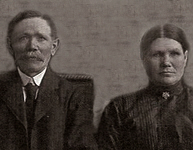 My great grandparents, Carl and Albertine Schumacher immigrated to the United States from Germany, before they even knew each other. When they arrived, they, like most immigrants, could not speak English very well. It made communication difficult in those early years. Eventually, they learned enough English to get by, but the family still spoke German in the home. German continued to be the home language for many years. In fact, it would take a teacher at the school where their two oldest children, Anna and Albert attended, who made fun of their language, to change their home life forever. When the children came home upset about the thoughtlessness of the teacher, my great grandmother, said, “That’s it!! From now on, this family will speak only English in this house!” She did it to protect her children from further ridicule, but looking back on that time now, I think it is a bit sad that the German language that had been a part of their heritage for generation and generations, was now lost forever. I know that my great grandparents probably always remembered the language, but for their children much of it was lost, and for their children, it was completely lost.
My great grandparents, Carl and Albertine Schumacher immigrated to the United States from Germany, before they even knew each other. When they arrived, they, like most immigrants, could not speak English very well. It made communication difficult in those early years. Eventually, they learned enough English to get by, but the family still spoke German in the home. German continued to be the home language for many years. In fact, it would take a teacher at the school where their two oldest children, Anna and Albert attended, who made fun of their language, to change their home life forever. When the children came home upset about the thoughtlessness of the teacher, my great grandmother, said, “That’s it!! From now on, this family will speak only English in this house!” She did it to protect her children from further ridicule, but looking back on that time now, I think it is a bit sad that the German language that had been a part of their heritage for generation and generations, was now lost forever. I know that my great grandparents probably always remembered the language, but for their children much of it was lost, and for their children, it was completely lost.
When I was in school, I fell in love with the German language, and took it in school for four years. It was so interesting to me to speak the German language, but the biggest problem was that I had no one to speak it with at home. I can see how speaking one language in the home and another at school could have become a problem for my grandmother and great uncle. It would be hard for them to learn English when German was spoken in the home. I know that the opposite made it very hard for me. The only time I got to speak German was the hour I had class each day. It would be especially confusing for younger children. Nevertheless, I think it could be done, and would have been beneficial for all of the children.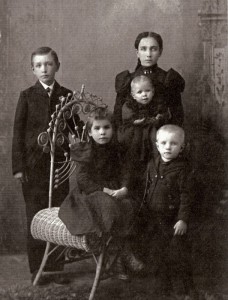
Over the years, I have been an advocate for English being our countries official language, and I still feel that way, but I also think it is great when people can speak more than one language. In my opinion, it is rude to speak another language in the company of people who cannot speak it back, because they invariably get the feeling that you are talking about them, and perhaps you are. Even if you aren’t, they will always believe you were. That is why I think it is important to consider those around you when choosing to speak a language that is not the common one to the area you are in. Of course, when you are not in a conversation with those around you, like in a grocery store, it’s a different thing. I think people should pass their heritage, culture, and language down to children and grandchildren, because it will never be something they regret giving them, but it is also important to embrace their new home when they immigrate, because that is where you will live, work, and socialize from then on.
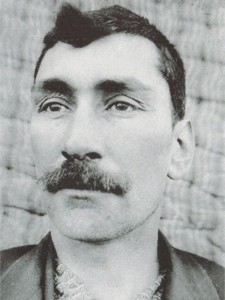 Like many people, my great grand uncle, Cornealius Spencer and his wife Leola Stinson Spencer left Iowa and made their way to Oklahoma in the spring of 1893. With them were their children and Leola’s parents. They had heard that the government was giving away land and they had decided to make a new start. The homestead they received was 160 acres, but the land came with qualifications. The homestead owner was required to fence the land, build a building, and live on the land for a period of one year before it became theirs. When I think of those reasonable qualifications, in light of today and all we have now, I think that the land they received was really cheap…and maybe it was, but times were different then, and living on a piece of land that had no improvements, and the soil was hard and rocky, might not have been so easy. They didn’t have the farming equipment we have now, so they had to till the ground with a team of horses or a yoke of oxen and a hand plow. They couldn’t just run down to the lumber store to buy building supplies. They had to cut down their own logs to build a home, or live in a sod hut…which many people then did for a time.
Like many people, my great grand uncle, Cornealius Spencer and his wife Leola Stinson Spencer left Iowa and made their way to Oklahoma in the spring of 1893. With them were their children and Leola’s parents. They had heard that the government was giving away land and they had decided to make a new start. The homestead they received was 160 acres, but the land came with qualifications. The homestead owner was required to fence the land, build a building, and live on the land for a period of one year before it became theirs. When I think of those reasonable qualifications, in light of today and all we have now, I think that the land they received was really cheap…and maybe it was, but times were different then, and living on a piece of land that had no improvements, and the soil was hard and rocky, might not have been so easy. They didn’t have the farming equipment we have now, so they had to till the ground with a team of horses or a yoke of oxen and a hand plow. They couldn’t just run down to the lumber store to buy building supplies. They had to cut down their own logs to build a home, or live in a sod hut…which many people then did for a time.
The families arrived with two covered wagons and Leola with two small children…four year old Oren and two year old Edith. The wagons were pulled by a pair of oxen. With no bits or lines to guide the oxen. They pulled the wagon by a yoke and Leola had to guide them by the voice commands or “gee” and “haw” for left and right and “whoa” for stop. The milk cow was tied to the wagon and the family brought along a coop of chickens. They camped out at night, and let the chickens eat the bugs in the area. There were no roads to get to Oklahoma, so they had to simply go across the prairie.
Once they arrived in Blaine county, the men filed on two places that were next to each other. Each place had a spring for water, until a well could be dug. They dug a dugout near the spring, and were settled by June 12, 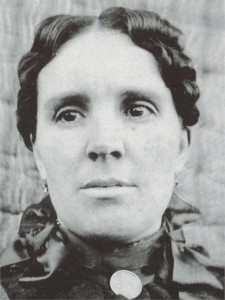 1893, when their new daughter Elsie Jane was born. They lived in the dugout until a home could be built. There were no towns close, so they had to rely on what they could hunt. Thankfully there was an abundance of deer, rabbits, turkeys, and even squirrels, so they never went hungry. Both Cornealius and Leola were excellent shots, so it didn’t matter who was available to hunt, both were able to get food for the family.
1893, when their new daughter Elsie Jane was born. They lived in the dugout until a home could be built. There were no towns close, so they had to rely on what they could hunt. Thankfully there was an abundance of deer, rabbits, turkeys, and even squirrels, so they never went hungry. Both Cornealius and Leola were excellent shots, so it didn’t matter who was available to hunt, both were able to get food for the family.
I can fully understand why it was so hard to make a homestead work now, because the supplies the homesteaders needed were not readily available. Many people gave up and headed back east, but my great grand uncle and his family stuck it out, and spent their remaining years in Oklahoma. They would raise their ten children there and were very successful in their endeavors. Homesteading wasn’t designed to be easy. Getting 160 acres of land is a big deal, and while the land ended up being free in the monetary sense, it certainly did not in the blood, sweat, and tears sense. The homesteader earned every inch of that property.
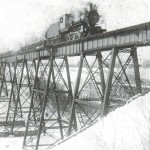 In their early years, the railroads were quite powerful companies, and with good reason. The railroad reduced travel time across the United States from days or months, to hours, in many cases. They brought supplies, payroll, and people from back east to the west quickly. The railroad did not come without some confusion, however. Even as late as the 1880s, most United States towns had their own system for keeping track of time, based on where the sun was at high noon. I had never given much thought to this, but I suppose it could have been a big mess, since the train’s arrival would be very mixed up, and the end result would be that the train might be scheduled to arrive in several places at once.
In their early years, the railroads were quite powerful companies, and with good reason. The railroad reduced travel time across the United States from days or months, to hours, in many cases. They brought supplies, payroll, and people from back east to the west quickly. The railroad did not come without some confusion, however. Even as late as the 1880s, most United States towns had their own system for keeping track of time, based on where the sun was at high noon. I had never given much thought to this, but I suppose it could have been a big mess, since the train’s arrival would be very mixed up, and the end result would be that the train might be scheduled to arrive in several places at once.
Because the railroads were quite powerful, they took it upon themselves to make a monumental change that would affect the entire nation, and Canada too. At exactly noon on this day in 1883, American and Canadian railroads broke the continent into four sections, and began using a system of time zones that we still use to this day, with very few changes made to it over the years. I’m sure there were people who did not like the new system much, but most people quickly embraced it, because their lives depended on the railroad in one way or another. The root of the problem they had was that they moved passengers and freight over the thousands of miles the line covered. With the varying times in towns along the route, the train 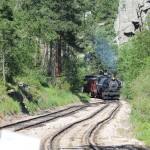 ended up with dozens of different departure and arrival times. No one really knew when the train would arrive…except possibly the engineer. I’m sure that caused chaos in the train stations…especially in the bigger cities. These days, we have to be at the airport two hours early for flights, because of screening, so imagine that kind of a scenario in the small train stations of the old west. This scheduling nightmare had to be stopped, and time zones were the only logical way to do it.
ended up with dozens of different departure and arrival times. No one really knew when the train would arrive…except possibly the engineer. I’m sure that caused chaos in the train stations…especially in the bigger cities. These days, we have to be at the airport two hours early for flights, because of screening, so imagine that kind of a scenario in the small train stations of the old west. This scheduling nightmare had to be stopped, and time zones were the only logical way to do it.
With the use of time zones, rail transportation became far more efficient. The thing that seems rather odd, is that they didn’t go to the United States or Canadian governments to resolve the problem, and if the government at that time was as inefficient as our congress is right now, I can fully understand why they didn’t. Imaging waiting six years to make a decision concerning time and its vital role in rail travel. Something had to be done right away, and the railroad was just bold enough to do it. As it turned out, no one tried to stop them either. I suppose everyone could see just how logical their plan was, and no one complained. So, the railroad companies agreed to create four continental time zones, and that decision has changed the way we live to this day.
The lines they adopted to make those time zones were very close to the ones we have today. I’m sure that any changes are based on where towns began to fall along the zone lines. It wasn’t until as late as 1918 that Congress officially adopted the railroad time zones and put them under the Interstate Commerce Commission. 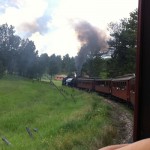 Just imagine, if you will, if the people and the railroad had waited for Congress to act on this matter. There would have been 35 more years of unorganized and frustrating railroad travel. Something that should have revolutionized travel, would have been relegated to the stone age again, because of Congress’ lack of action. Even after the system was implemented and people finally had an organized schedule, that was relatively accurate…because you can’t predict accidents or weather related delays very well, Congress sat on their hands, and I suppose they operated the government on government time instead. In this writer’s opinion, the time zones were a wonderful idea, and have benefitted this nation very well since 1883. My family has a long history of working on the railroad, and that is a fact that I am very proud of.
Just imagine, if you will, if the people and the railroad had waited for Congress to act on this matter. There would have been 35 more years of unorganized and frustrating railroad travel. Something that should have revolutionized travel, would have been relegated to the stone age again, because of Congress’ lack of action. Even after the system was implemented and people finally had an organized schedule, that was relatively accurate…because you can’t predict accidents or weather related delays very well, Congress sat on their hands, and I suppose they operated the government on government time instead. In this writer’s opinion, the time zones were a wonderful idea, and have benefitted this nation very well since 1883. My family has a long history of working on the railroad, and that is a fact that I am very proud of.
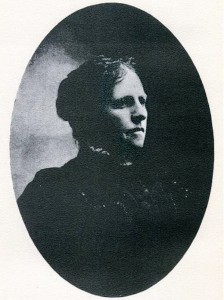 When Hattie Goodman, who is my husband, Bob’s 3rd cousin 4 times removed, wrote her family history book about the Knox family, back in 1905, computers and the internet were far in the future. The Knox family knew that their roots were is Scotland, but during her lifetime, the connection was never made. Having searched, fruitlessly at times, for my own roots, I can relate to the frustration she must have felt at hitting that brick wall. I can’t imagine how slow the process must have been when the only ways to search the records were by mail or a personal visit to the city whose records you were researching…or word of mouth, which can be highly unreliable. Her own search ended with her passing, but since that time, much has changed in the genealogy realm.
When Hattie Goodman, who is my husband, Bob’s 3rd cousin 4 times removed, wrote her family history book about the Knox family, back in 1905, computers and the internet were far in the future. The Knox family knew that their roots were is Scotland, but during her lifetime, the connection was never made. Having searched, fruitlessly at times, for my own roots, I can relate to the frustration she must have felt at hitting that brick wall. I can’t imagine how slow the process must have been when the only ways to search the records were by mail or a personal visit to the city whose records you were researching…or word of mouth, which can be highly unreliable. Her own search ended with her passing, but since that time, much has changed in the genealogy realm.
While she was unable to link the Knox family to Scotland, that link has since been made. According to John Knox, of the Knox-Laffoon clan, “John Knox, emigrant progenitor, represented by the trunk of our Knox Family Tree, was a native of Scotland, born about the year 1708. The exact locality of his birthplace is not certainly known. Some of the descendants on two different branches have it by tradition that Renfrewshire was his native place. He went from Scotland to Ireland, with other Scotch emigrants, by invitation of the King of England, to constitute a balance of power against the insurgent Irish Catholics. He married an Irish Presbyterian wife, Miss Jean Gracy, whose mother’s name was Jean Sinclair. They emigrated to America (from Coleraine, Ireland) about 1740, in company with his brother-in-law, Patrick Gracy, and others. It is thought that he first settled in Pennsylvania before coming South to Carolina. He was one of the early settlers of Rowan county, N. C. He bought six hundred acres of land on the south side of Third Creek for £37, 10s., which land had been granted by Earl Granville to James Stuart.”
At some point, my father-in-law, Walter Schulenberg, who had married my mother-in-law, Joann Knox, was given a CD containing much of the history of the Knox family, in the form of Hattie Goodman’s book and many family pictures. I downloaded that to my computer, and have since very much enjoyed reading her writings, and especially enjoyed all the pictures that were included. I have used several of them in previous writings about the Knox family. What a wonderful thing for someone to have transferred all that information to a CD, where it could be shared and enjoyed by so many people. Originally, Reverend James Knox drew a sketch of his family tree, as far back as he knew. During Hattie’s lifetime, she was able to add many people to the original tree, and in the end produced a wonderful heirloom tree with about 2,200 names on it. Many copies were made and given to various family members. I was privileged enough to be able to see one of those copies when Bob and I visited 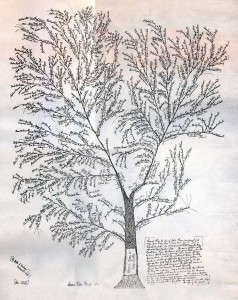 his great grandparents, Edgar and Nellie Knox in September of 1976. It was a magnificent tree, and while I can provide a copy here, it could never be as impressive as the extra large one I got to see.
his great grandparents, Edgar and Nellie Knox in September of 1976. It was a magnificent tree, and while I can provide a copy here, it could never be as impressive as the extra large one I got to see.
I suppose that many people might think that today’s ability to research family histories is almost cheating, but I think it is better to be able to find the answers…even if it’s taking the easy way, than never to find the answers at all. These days, the research has gone far beyond pouring over records stored in some dark basement room at city hall. Besides the internet, and the vast amount of records that are shared there every day, there are also DNA connections. I have had my DNA analyzed, and have connected with many family members from that one test. It is amazing how far we have come, and I think that in the future, we may find ourselves even closer to being able to connect to our roots, be they Scottish or one of the many other nationalities.
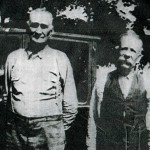 After my 2nd great grandfather, Allen Spencer passed away suddenly at the young age of just 56 years, my 2nd great grandmother, Lydia Spencer found herself in one of the hardest positions anyone ever has to face. In those days, few of the women worked outside the home, and with her husband and the bread winner of her family gone, she had some hard choices to make. She still had several children at home, including three sons and one daughter. Her daughter, Teresa would marry later that year, and eventually move to North Dakota. Her son Allen would follow his sister to North Dakota, and eventually move to Washington, where he would marry and live out his life. That left Lydia in Iowa, with her two remaining sons, Cornelius and Luther…at least for a time. That had to have been the hardest part of the time too, considering the grief she must have been feeing.
After my 2nd great grandfather, Allen Spencer passed away suddenly at the young age of just 56 years, my 2nd great grandmother, Lydia Spencer found herself in one of the hardest positions anyone ever has to face. In those days, few of the women worked outside the home, and with her husband and the bread winner of her family gone, she had some hard choices to make. She still had several children at home, including three sons and one daughter. Her daughter, Teresa would marry later that year, and eventually move to North Dakota. Her son Allen would follow his sister to North Dakota, and eventually move to Washington, where he would marry and live out his life. That left Lydia in Iowa, with her two remaining sons, Cornelius and Luther…at least for a time. That had to have been the hardest part of the time too, considering the grief she must have been feeing.
Luther married Ellen Dykes in 1885, and Cornealius married Leona Stinson on February 1, 1888. By 1900, the two brothers along with their families and their mother had moved to the Deer Creek, Oklahoma area. I know that in the years following their fathers death, these two men took on the role of caregiver of sorts for their mother. It wasn’t necessarily that she needed a caregiver, at only 53 years of age, but rather that these two brothers took on the role of picking up the pieces of her shattered life and helping her through the rough transition years, during which she went from being a wife to a widow. It isn’t that she was incapable, but it would be really hard to find yourself widowed at such a young age. You had thought you and your souse would grow old together, and now you have been left to try to figure out how to move on alone.
Little has been said about the role the two brothers played in her life, and I suppose that is because it was just expected of them and so everyone assumed they just did their job. I suppose that is true to a large degree, but there were other children in the family, and yet they chose to take on this role, and she chose to go to Oklahoma with these two sons, rather than move to North Dakota, Wisconsin, or Washington with her other children. She loved the others very much, and the pictures tell me that she saw them whenever she could, but she moved to Oklahoma with Cornealius and Luther, and lived in Luther’s home until her passing in 1906, at the age of 75.
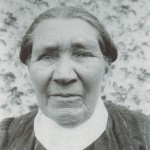 It takes a very special person to move their elderly parent into their home, and I don’t just mean that parent’s child, but the spouse of that child too. You can’t take in your parent without the ok of your spouse, because this is going to affect the whole family. In this case, it is likely that the time Lydia lived with her son Luther and his family in Oklahoma, was about ten years, but in reality, that is a long time. The last days could have been very stressful and trying, given the way, aging parents get weak and tired as they get closer to death. Yes, I think that Luther and his wife, Ellen had to be very special people to make sure that Lydia was taken care of, and not lonely. I’m sure that went a long way toward picking up the pieces of her life, after the loss of her husband, Allen. That leaves me with a lot of respect for these sons and their families.
It takes a very special person to move their elderly parent into their home, and I don’t just mean that parent’s child, but the spouse of that child too. You can’t take in your parent without the ok of your spouse, because this is going to affect the whole family. In this case, it is likely that the time Lydia lived with her son Luther and his family in Oklahoma, was about ten years, but in reality, that is a long time. The last days could have been very stressful and trying, given the way, aging parents get weak and tired as they get closer to death. Yes, I think that Luther and his wife, Ellen had to be very special people to make sure that Lydia was taken care of, and not lonely. I’m sure that went a long way toward picking up the pieces of her life, after the loss of her husband, Allen. That leaves me with a lot of respect for these sons and their families.

